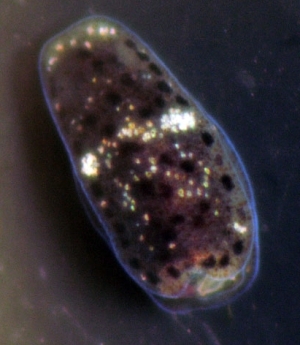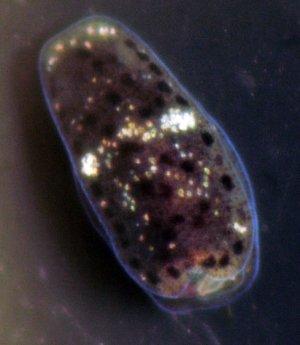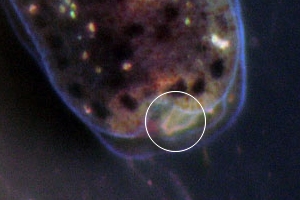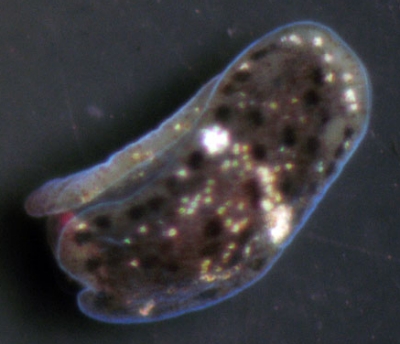
Runcinid sp. 1
Order: CEPHALASPIDEA
Superfamily: RUNCINOIDEA
DISTRIBUTION
Known from eastern Australia - sthn Queensland, New South Wales
PHOTO
Locality: Alexandra Headland, Mooloolaba, 50mm, Queensland, Australia, Pacific Ocean, 02 February 2008, Intertidal. Length: 0.8mm. Photographer: Gary Cobb.
Appears to have external shell. Generic and Family placement not possible without anatomical examination.
Authorship detailsRudman, W.B., 2008 (December 15) Runcinid sp. 1 [In] Sea Slug Forum. Australian Museum, Sydney. Available from http://www.seaslugforum.net/find/runcsp1
Related messages
Runcina? from sthn Queensland
December 16, 2008
From: Gary Cobb


Concerning message #14776:
Hi Bill and everyone!
Here's a giant! We are calling it Runcina sp. but it resembles Runcina adriatica from France. It was found using anaerobic extraction which simply involves placing the encrusted rock into a bowl of sea water and waiting until the animals are drawn out. This method was named by us and has been very productive.
The main feature of this species is the white collar which is made of white specs. And there is red patch at the anterior end of the animal that we can't figure out.
Locality: Alexandra Headland, Mooloolaba, 50 mm, Queensland, Australia, Pacific Ocean, 02 February 2008, Intertidal. Length: 0.8 mm. Photographer: Gary Cobb.
It always amazes me the beauty of even the smallest critter found in the sea.
Cheers
Gary
gary@nudibranch.com.au
Cobb, G.C., 2008 (Dec 16) Runcina? from sthn Queensland. [Message in] Sea Slug Forum. Australian Museum, Sydney. Available from http://www.seaslugforum.net/find/22079
Dear Gary,
Thanks for these photos. I have found this a number of times in sthn Queensland and New South Wales but usually by the same method as you - in a dish of 'remnants' often very sick after crawling out of dying vegetation. Consequently I have drawings but no photos of much use. The end with the red spot is not the head but the 'tail'. In most runcinoideans the little overlapping edge of the mantle at the tail end of the body hides one or a group of small gills, and if there is a shell it is a small flattened plate hidden in the mantle skin. However in your animal the shell seems to be a small external plate - which I have ringed - and gills seem to be absent. The only species we know with an external shell is Ildica nana but we know very little about that species.
I have no idea what the red patch is. It could be a gland or perhaps a bit of debris caught on the foot?
The runcinoideans are all small and most are known from only a few specimens, in some cases from single preserved animals. Until we know something about the anatomy of this species I can't really say what genus it belongs to so I think it is safer to call it Runcinid sp. 1.
Best wishes,
Bill Rudman
